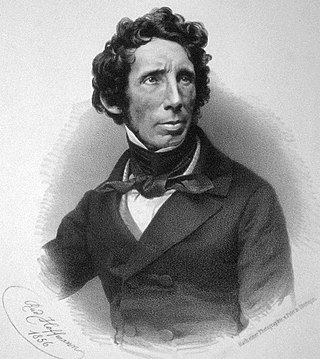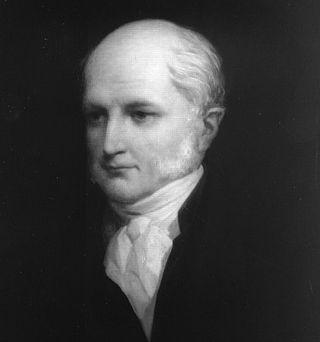Related Research Articles

Friedrich Wöhler FRS(For) HonFRSE was a German chemist known for his work in both organic and inorganic chemistry, being the first to isolate the chemical elements beryllium and yttrium in pure metallic form. He was the first to prepare several inorganic compounds, including silane and silicon nitride.

Justus Freiherr von Liebig was a German scientist who made major contributions to agricultural and biological chemistry, and is considered one of the principal founders of organic chemistry. As a professor at the University of Giessen, he devised the modern laboratory-oriented teaching method, and for such innovations, he is regarded as one of the greatest chemistry teachers of all time. He has been described as the "father of the fertilizer industry" for his emphasis on nitrogen and trace minerals as essential plant nutrients, and his formulation of the law of the minimum, which described how plant growth relied on the scarcest nutrient resource, rather than the total amount of resources available. He also developed a manufacturing process for beef extracts, and with his consent a company, called Liebig Extract of Meat Company, was founded to exploit the concept; it later introduced the Oxo brand beef bouillon cube. He popularized an earlier invention for condensing vapors, which came to be known as the Liebig condenser.

William Prout FRS was an English chemist, physician, and natural theologian. He is remembered today mainly for what is called Prout's hypothesis.
Prout's hypothesis was an early 19th-century attempt to explain the existence of the various chemical elements through a hypothesis regarding the internal structure of the atom. In 1815 and 1816, the English chemist William Prout published two papers in which he observed that the atomic weights that had been measured for the elements known at that time appeared to be whole multiples of the atomic weight of hydrogen. He then hypothesized that the hydrogen atom was the only truly fundamental object, which he called protyle, and that the atoms of other elements were actually groupings of various numbers of hydrogen atoms.
The year 1832 in science and technology involved some significant events, listed below.

August Wilhelm von Hofmann was a German chemist who made considerable contributions to organic chemistry. His research on aniline helped lay the basis of the aniline-dye industry, and his research on coal tar laid the groundwork for his student Charles Mansfield's practical methods for extracting benzene and toluene and converting them into nitro compounds and amines. Hofmann's discoveries include formaldehyde, hydrazobenzene, the isonitriles, and allyl alcohol. He prepared three ethylamines and tetraethylammonium compounds and established their structural relationship to ammonia.
Karl Wilhelm Gottlob Kastner was a German chemist, natural scientist and a professor of physics and chemistry.
The Chemical Society was a scientific society formed in 1841 by 77 scientists as a result of increased interest in scientific matters. Chemist Robert Warington was the driving force behind its creation.
In organic chemistry, Zaytsev's rule is an empirical rule for predicting the favored alkene product(s) in elimination reactions. While at the University of Kazan, Russian chemist Alexander Zaytsev studied a variety of different elimination reactions and observed a general trend in the resulting alkenes. Based on this trend, Zaytsev proposed that the alkene formed in greatest amount is that which corresponded to removal of the hydrogen from the alpha-carbon having the fewest hydrogen substituents. For example, when 2-iodobutane is treated with alcoholic potassium hydroxide (KOH), but-2-ene is the major product and but-1-ene is the minor product.
Robert Angus Smith FRS was a Scottish chemist, who investigated numerous environmental issues. He is known for his research on air pollution in 1852, in the course of which he discovered what came to be known as acid rain. He is sometimes referred to as the 'Father of Acid Rain'.

Dr James Sheridan Muspratt FRSE FRSD was an Irish-born research chemist and teacher. His most influential publication was his two-volume book Chemistry, Theoretical, Practical and Analytical as applied and relating to the Arts and Manufactures (1857–1860).

Meat extract is highly concentrated meat stock, usually made from beef or chicken. It is used to add meat flavor in cooking, and to make broth for soups and other liquid-based foods.
Edmund Davy FRS was a professor of chemistry at the Royal Cork Institution from 1813 and at the Royal Dublin Society from 1826. He discovered acetylene, as it was later named by Marcellin Berthelot. He was also an original member of the Chemical Society, and a member of the Royal Irish Academy.
Pat Munday is an American environmentalist, writer, and college professor living in Butte, Montana. He was awarded the Liebig-Woehler Freundschaft Prize for scholarship in the history of chemistry, and contributions through environmental activism.

Johann Peter Griess was an industrial chemist and an early pioneer of organic chemistry. Griess was influential in the formation of modern dyes, first formulating the diazotization reaction of arylamines.

Jacob Volhard was the German chemist who discovered, together with his student Hugo Erdmann, the Volhard–Erdmann cyclization reaction. He was also responsible for the improvement of the Hell–Volhard–Zelinsky halogenation.

The German Chemical Society is a learned society and professional association founded in 1949 to represent the interests of German chemists in local, national and international contexts. GDCh "brings together people working in chemistry and the molecular sciences and supports their striving for positive, sustainable scientific advance – for the good of humankind and the environment, and a future worth living for."
Max Speter was a Jewish-German chemist and science historian.

John Buddle Blyth was a Jamaican-born chemist who was the first professor of chemistry at Queen's College Cork in Ireland. With August Wilhelm von Hofmann, he was the first to report photopolymerisation which they observed when styrene became metastyrol after exposure to sunlight.
References
- ↑ Biography of William Hodson Brock. (2006). Division of History of Chemistry of the American Chemical Society.
- ↑ Rocke, A. J. (1986). Justus von Liebig und August Wilhelm Hofmann in ihren Briefen (1841-1873) by William Hodson Brock. Isis, Vol. 77, No. 2. pp. 380-381.
- ↑ "Dexter Award for Outstanding Achievement in the History of Chemistry". Division of the History of Chemistry. American Chemical Society. Retrieved 30 April 2015.
- ↑ Brooke, John Hedley (June 1994). "Review of The Fontana History of Chemistry by William H. Brock". Isis. 85 (2): 301–302. doi:10.1086/356820.
- ↑ Kauffman, George B. (1 August 1994). "Review of The Norton History of Chemistry by William H. Brock". J. Chem. Educ. 71 (8): A214. doi: 10.1021/ed071pA214 .